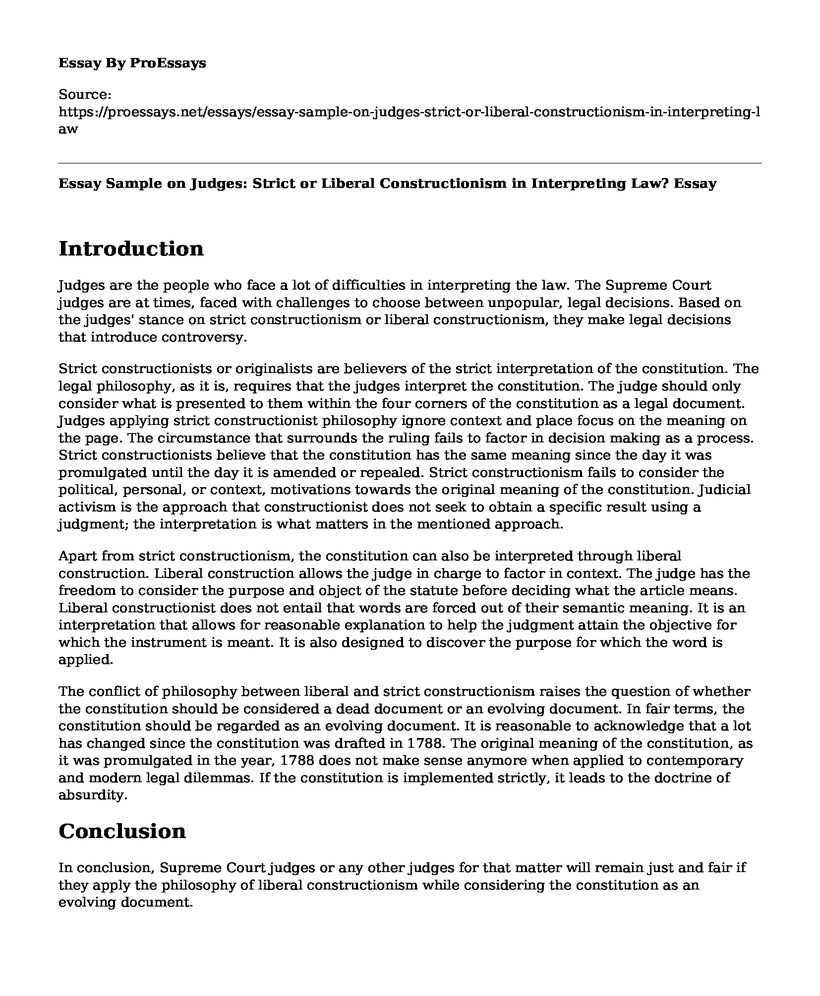Introduction
Judges are the people who face a lot of difficulties in interpreting the law. The Supreme Court judges are at times, faced with challenges to choose between unpopular, legal decisions. Based on the judges' stance on strict constructionism or liberal constructionism, they make legal decisions that introduce controversy.
Strict constructionists or originalists are believers of the strict interpretation of the constitution. The legal philosophy, as it is, requires that the judges interpret the constitution. The judge should only consider what is presented to them within the four corners of the constitution as a legal document. Judges applying strict constructionist philosophy ignore context and place focus on the meaning on the page. The circumstance that surrounds the ruling fails to factor in decision making as a process. Strict constructionists believe that the constitution has the same meaning since the day it was promulgated until the day it is amended or repealed. Strict constructionism fails to consider the political, personal, or context, motivations towards the original meaning of the constitution. Judicial activism is the approach that constructionist does not seek to obtain a specific result using a judgment; the interpretation is what matters in the mentioned approach.
Apart from strict constructionism, the constitution can also be interpreted through liberal construction. Liberal construction allows the judge in charge to factor in context. The judge has the freedom to consider the purpose and object of the statute before deciding what the article means. Liberal constructionist does not entail that words are forced out of their semantic meaning. It is an interpretation that allows for reasonable explanation to help the judgment attain the objective for which the instrument is meant. It is also designed to discover the purpose for which the word is applied.
The conflict of philosophy between liberal and strict constructionism raises the question of whether the constitution should be considered a dead document or an evolving document. In fair terms, the constitution should be regarded as an evolving document. It is reasonable to acknowledge that a lot has changed since the constitution was drafted in 1788. The original meaning of the constitution, as it was promulgated in the year, 1788 does not make sense anymore when applied to contemporary and modern legal dilemmas. If the constitution is implemented strictly, it leads to the doctrine of absurdity.
Conclusion
In conclusion, Supreme Court judges or any other judges for that matter will remain just and fair if they apply the philosophy of liberal constructionism while considering the constitution as an evolving document.
Works Cited
Barber, Paul. "The New Religious Freedom Restoration Act and Its Effects on Student-Athletes." JL & Educ. 46 (2017): 145.
Holmes, Kate Garand, and James C. Garand. "The Clash of Rights: Explaining Attitudes toward a Religious Exemption to the HHS Contraception Mandate." PS: Political Science & Politics 51.2 (2018): 358-369.
Muchlinski, David. "The Politics and Effects of Religious Grievance." Oxford Research Encyclopedia of Politics. 2019.
Cite this page
Essay Sample on Judges: Strict or Liberal Constructionism in Interpreting Law?. (2023, Apr 24). Retrieved from https://proessays.net/essays/essay-sample-on-judges-strict-or-liberal-constructionism-in-interpreting-law
If you are the original author of this essay and no longer wish to have it published on the ProEssays website, please click below to request its removal:
- Research Paper on Examination and Arrest of Illegal Immigrants
- Criminology and Domestic Violence in UK Essay Example
- Essay Example on Technology and Privacy: Big Brother Is Watching?
- Research Paper on Black Panther Party: Working Towards Social Justice and Equality
- Essay Example on HIPAA: Protecting Patients' Personal Health Information
- Essay Example on Abortion Debate: Pro-Choice and Pro-Life Views in 2021
- Reducing Recidivism: Examining Transitional Procedures and Programs for Successful Prison Re-Entry







